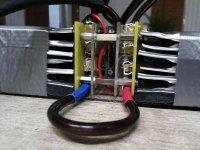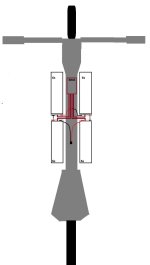Hello fellow members of Endless-sphere,
I'm seeking guidance to help me make my own A123 LifePo4 split battery pack.
Until now my setup was this:
View attachment 2
My range was about 15-20Km with some light pedalling. I would like to add more range and more security and why not some lifespan.
This seems to all come to using LifePo4 A123 prismatic AMP20M1HD-A battery cells.
It seems hard to find genuine cells. Cell_Man seems to be the man. I'm not sure about OSN?
So where to buy? What's the price?
My goal is also to make a 24s split battery pack.
How I would like to do it:
For the battery pack, I need to find the best place for the battery cells on my bike for an appropriate balance between the front and rear. I would like more weight at front of the bike for better control and front tire traction. I also changed my front suspension with a ROCKSHOX suspension RECON Silver TK Coil 100 mm Noir 2013. This has made the bicycle tire traction way better and reduced handlebar vibrations. But it’s still a little light at the front of the bike. I want to keep the bike as off road as possible.
But I also need range, so I’m looking into A123 prismatic cells from Cell_Man to create a homemade 24s split battery pack. I want to place 12 cells on each side of the bike, to make a 24s battery pack with BMS.
Here is a picture found on endless-sphere which illustrates pretty much how to connect the battery together. I would like to place on each side of the bike; 2 separate 6s battery packs, which will be set head to head like this picture. The reason I want to use head to head is to reduce as possible wire length and keep vulnerable parts together and not space out. To attach the cells, I’ll use Agniusm’s A123 AMP20M1HD-A Battery pack 6S kit. Then I still need to find a way to keep the cells head to head. In this picture it doesn’t seem have much as structural strength if I were to place this on the side of the bike between my legs. My goal isn’t to reproduce exactly this idea, but to evolve this idea towards my project.
Keep in mind, I going to build it to be able to dismantle it if any problems arise.

Fig A; 12s --> 2 x 6 cells head to head.
This sketch will help you imagine my idea.

How is a BMS connected to the battery pack, controller, and charger?
Here is a picture supplied by Em3ev for a 24S 80A BMS.
It says to connect each negative wire to the bms. This leaves us with a positive wire for the controller, charger and battery pack. Does this mean all these positive wires are connected together?
So if I’m not mistaken, I need to choose appropriate controller to accept charging voltage.
When I charge the battery pack, will the controller be on/powered up?
Does the controller ignition wire need to be connected to the BMS? Or could just leave it connected the positive wire with a switch in between.
Does Cycle Analyste power up and show battery/charger voltage?
View attachment 3
What do you guys and girls think of all this?? What am i missing?
Any ideas? Feel free to post info, links suggestions.
Best regards,
Danoussh
I'm seeking guidance to help me make my own A123 LifePo4 split battery pack.
Until now my setup was this:
- - Bike - Rockrider 6.3 2013 – Decathlon http://www.decathlon.fr/rockrider-63-id_8103
- Magic Pie 3 26” motor, removed internal controller, replaced phase wires with 2.5mm copper wire, added temp sensor for later.
- 12 FET 3077 Mark II Extreme Modder LYEN Edition Controller Motor 40A.
- 6 x 6 cell Turnigy 5000mAh / 20-30 c discharge LIPO – 3bats in series and then paralleled with another 3 in series = 10ah 72Volt. No BMS!!! <--- BAD
View attachment 2
My range was about 15-20Km with some light pedalling. I would like to add more range and more security and why not some lifespan.
This seems to all come to using LifePo4 A123 prismatic AMP20M1HD-A battery cells.
It seems hard to find genuine cells. Cell_Man seems to be the man. I'm not sure about OSN?
So where to buy? What's the price?
My goal is also to make a 24s split battery pack.
How I would like to do it:
For the battery pack, I need to find the best place for the battery cells on my bike for an appropriate balance between the front and rear. I would like more weight at front of the bike for better control and front tire traction. I also changed my front suspension with a ROCKSHOX suspension RECON Silver TK Coil 100 mm Noir 2013. This has made the bicycle tire traction way better and reduced handlebar vibrations. But it’s still a little light at the front of the bike. I want to keep the bike as off road as possible.
But I also need range, so I’m looking into A123 prismatic cells from Cell_Man to create a homemade 24s split battery pack. I want to place 12 cells on each side of the bike, to make a 24s battery pack with BMS.
Here is a picture found on endless-sphere which illustrates pretty much how to connect the battery together. I would like to place on each side of the bike; 2 separate 6s battery packs, which will be set head to head like this picture. The reason I want to use head to head is to reduce as possible wire length and keep vulnerable parts together and not space out. To attach the cells, I’ll use Agniusm’s A123 AMP20M1HD-A Battery pack 6S kit. Then I still need to find a way to keep the cells head to head. In this picture it doesn’t seem have much as structural strength if I were to place this on the side of the bike between my legs. My goal isn’t to reproduce exactly this idea, but to evolve this idea towards my project.
Keep in mind, I going to build it to be able to dismantle it if any problems arise.

Fig A; 12s --> 2 x 6 cells head to head.
This sketch will help you imagine my idea.

How is a BMS connected to the battery pack, controller, and charger?
Here is a picture supplied by Em3ev for a 24S 80A BMS.
It says to connect each negative wire to the bms. This leaves us with a positive wire for the controller, charger and battery pack. Does this mean all these positive wires are connected together?
So if I’m not mistaken, I need to choose appropriate controller to accept charging voltage.
When I charge the battery pack, will the controller be on/powered up?
Does the controller ignition wire need to be connected to the BMS? Or could just leave it connected the positive wire with a switch in between.
Does Cycle Analyste power up and show battery/charger voltage?
View attachment 3
What do you guys and girls think of all this?? What am i missing?
Any ideas? Feel free to post info, links suggestions.
Best regards,
Danoussh

